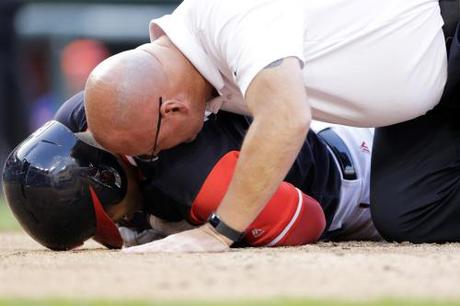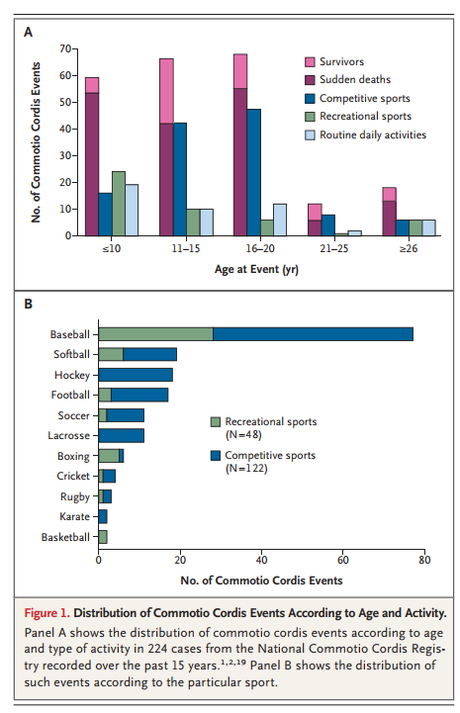
(AP Photo/Mark Tenally)
On Saturday, Nats batter Adrian Sanchez turned in towards a pitch as he attempted to bunt. But the 96-mph pitch headed straight for him, and the baseball struck him in the chest. He clutched his chest and collapsed to the ground where he remained for several minutes. Athletic trainer ran over, probably terrified of commotio cordis, a deadly injury caused by an unlucky strike to the chest in front of the heart.
Commotio cordis, Latin for “agitation of the heart,” is a bizarre condition where when a physical blow to the chest hits the heart during a particularly vulnerable moment in the heartbeat, it can cause a sudden heart attack.

Maron and Estes, 2010
The heart attack isn’t due to physical damage; in fact, the blow usually doesn’t even damage the bones overlying the heart, but it’s thought that the mechanical energy affects the proteins like ion channels in the heart, opening them aberrantly and ultimately causing ventricular fibrillations. Essentially, heart cells in the ventricle normally are electrically synchronized so they contract together, and this unified contraction collapses the heart chambers and pumps blood. But in commotio cordis, the impact to the chest disrupts that synchronization. Different heart cells start contracting at different times from one another, and the heart can’t fully contract and efficiently pump blood. Instead, it fibrillates, with different regions making small ineffectual contractions. Defibrillators, the pads first-responders attach to the chest to “jump-start” the heart, work by sending an electrical signal over the heart which is strong-enough to resynchronize the heart cells, so they again contract together and pump blood.
Sanchez recovered, and played out part of the rest of the game, even getting a base hit, before they sent him off to the hospital for monitoring, but not everyone is so lucky.
The very same day a 20-year-old Milwaukee Brewers minor-leaguer Julio Mendez was also struck by a pitch. An eye-witness report given on reddit said his breathing stopped, and trainers performed CPR as they waited for paramedics to arrive. The paramedics defibrillated the heart and took him to the hospital, where the Washington post reported today that he was in in a “critical but stable condition.”
Commotio cordis is a rare condition, but these two incidents are representative as younger players seem to be more vulnerable. According to the New England Journal of Medicine (NEJM), “it occurs primarily in children, adolescents, and young adults, most often during participation in certain recreational or competitive sports.” And of recreational and competitive sports, baseball is by far the most common cause of commotio cordis.

These deaths in young athletes may be preventable, according to that same NEJM article, “A direct relation between the hardness of the ball and the likelihood of ventricular fibrillation has been demonstrated in the laboratory, and lethal arrhythmias occur less frequently when the balls used have been manufactured for reduced hardness.” However, even softer baseballs made out of rubber as opposed to twine and cork have still caused commotio cordis.
In addition to recommending softer balls, the NEJM article recommends increasing awareness about commotio cordis and training young players to turn away from pitches coming at them, and also greater availability of defibrillators, as quickly restarting the heart increases the chance of survival from any heart attack, including one induced by commotio cordis.
Advertisements
